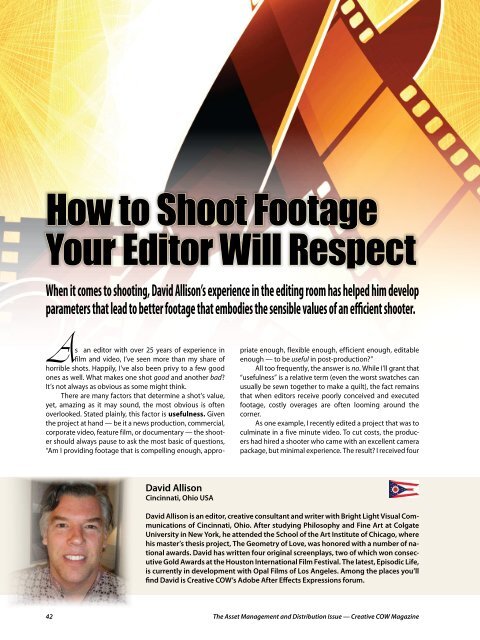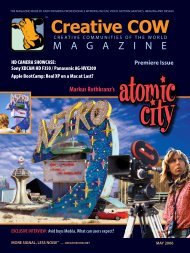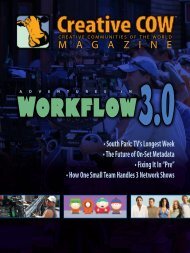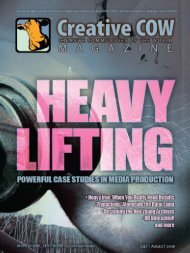Read the COW Magazine Online - Creative COW Magazine
Read the COW Magazine Online - Creative COW Magazine
Read the COW Magazine Online - Creative COW Magazine
You also want an ePaper? Increase the reach of your titles
YUMPU automatically turns print PDFs into web optimized ePapers that Google loves.
How to Shoot Footage<br />
Your Editor Will Respect<br />
When it comes to shooting, David Allison’s experience in <strong>the</strong> editing room has helped him develop<br />
parameters that lead to better footage that embodies <strong>the</strong> sensible values of an efficient shooter.<br />
A s an editor with over 25 years of experience in<br />
film and video, I’ve seen more than my share of<br />
horrible shots. Happily, I’ve also been privy to a few good<br />
ones as well. What makes one shot good and ano<strong>the</strong>r bad?<br />
It’s not always as obvious as some might think.<br />
There are many factors that determine a shot’s value,<br />
yet, amazing as it may sound, <strong>the</strong> most obvious is often<br />
overlooked. Stated plainly, this factor is usefulness. Given<br />
<strong>the</strong> project at hand — be it a news production, commercial,<br />
corporate video, feature film, or documentary — <strong>the</strong> shooter<br />
should always pause to ask <strong>the</strong> most basic of questions,<br />
“Am I providing footage that is compelling enough, appro-<br />
42<br />
David Allison<br />
Cincinnati, Ohio USA<br />
priate enough, flexible enough, efficient enough, editable<br />
enough — to be useful in post-production?”<br />
All too frequently, <strong>the</strong> answer is no. While I’ll grant that<br />
“usefulness” is a relative term (even <strong>the</strong> worst swatches can<br />
usually be sewn toge<strong>the</strong>r to make a quilt), <strong>the</strong> fact remains<br />
that when editors receive poorly conceived and executed<br />
footage, costly overages are often looming around <strong>the</strong><br />
corner.<br />
As one example, I recently edited a project that was to<br />
culminate in a five minute video. To cut costs, <strong>the</strong> producers<br />
had hired a shooter who came with an excellent camera<br />
package, but minimal experience. The result? I received four<br />
David Allison is an editor, creative consultant and writer with Bright Light Visual Communications<br />
of Cincinnati, Ohio. After studying Philosophy and Fine Art at Colgate<br />
University in New York, he attended <strong>the</strong> School of <strong>the</strong> Art Institute of Chicago, where<br />
his master’s <strong>the</strong>sis project, The Geometry of Love, was honored with a number of national<br />
awards. David has written four original screenplays, two of which won consecutive<br />
Gold Awards at <strong>the</strong> Houston International Film Festival. The latest, Episodic Life,<br />
is currently in development with Opal Films of Los Angeles. Among <strong>the</strong> places you’ll<br />
find David is <strong>Creative</strong> <strong>COW</strong>’s Adobe After Effects Expressions forum.<br />
The Asset Management and Distribution Issue — <strong>Creative</strong> <strong>COW</strong> <strong>Magazine</strong><br />
and a half hours of material, 25 minutes of which was useable.<br />
Let me repeat that: I received four and a half hours of<br />
material to edit a five-minute video — bad enough — yet<br />
only 25 minutes of it was even remotely useful!!! (Fade-up<br />
scream SFX.)<br />
To say that <strong>the</strong> decision to hire an inexpensive shooter<br />
cost more money than it saved would be an understatement.<br />
Without going into too much detail, just ponder <strong>the</strong><br />
extra time I spent making data space for 4½ hours of material,<br />
ingesting 4½ hours of material, reviewing 4½ hours of<br />
material, culling shots from 4½ hours of material, dealing<br />
with system sluggishness brought on by 4½ hours of material<br />
etc., etc. so on and so forth, multiplied by seventeen days<br />
of editing.<br />
Is it any wonder why I eventually decided to put gripes<br />
like this down on paper?<br />
In addition to being an editor, I’ve also experienced<br />
what it’s like to be a director, producer, writer, and, yes, a<br />
shooter. I’ve studied under people who’ve studied under<br />
Orson Welles. I’ve worked in <strong>the</strong> realm of <strong>the</strong> avant-garde<br />
with figures of varying quirkiness, such as Peter Kubelka<br />
and P. Adams Sitney. I’ve logged long hours with A-list, commercial<br />
directors who’ve agonized over <strong>the</strong> best way to sell<br />
donuts and cottage cheese.<br />
Through it all, I’ve developed a reasonably good feel<br />
for The Big Picture: Why are we all doing what we are doing?<br />
What particulars help (or hurt) <strong>the</strong> process that leads to <strong>the</strong> end<br />
goal?<br />
When it comes to shooting, my experience in <strong>the</strong> editing<br />
room has helped me develop parameters that lead to<br />
better footage. While I tend not to think of <strong>the</strong>se parameters<br />
as rigid or static (we’re not talking “The Ten Commandments”<br />
here), a list of common problems — and common<br />
solutions — has naturally taken form over <strong>the</strong> years. I eventually<br />
ga<strong>the</strong>red <strong>the</strong> list under one umbrella, which I fondly<br />
call: How to Shoot Video Your Editor Will Respect In <strong>the</strong> Morning.<br />
QUITTERS NEVER WIN (except in production)<br />
Imagine for a moment that you are in <strong>the</strong> editing room,<br />
watching your editor pore over some footage you shot.<br />
(You should always imagine this, by <strong>the</strong> way). Now let’s say<br />
you arrive at a series of tabletop product shots. In <strong>the</strong> first<br />
shot, you accidently “miss <strong>the</strong> landing pad” (or as Mary Lou<br />
Retton would say, you didn’t “stick it”).<br />
This is harmless enough. No shooters are automatons,<br />
and “sticking <strong>the</strong> landing” can be tricky business. The editor<br />
watches in silence as you stay with your final position for<br />
<strong>the</strong> traditional five seconds.<br />
Shot 2 comes along. Again, you don’t quite nail <strong>the</strong> final<br />
position, but dutifully stay with it — hoping that something<br />
salvageable might result.<br />
Shot 3 represents a variation on <strong>the</strong> <strong>the</strong>me: you miss<br />
<strong>the</strong> landing, but proceed to sneak back with <strong>the</strong> camera until<br />
you arrive at a flawlessly composed, final position.<br />
After ten similar attempts, just when evidence is developing<br />
that you’re getting closer and closer to <strong>the</strong> Holy<br />
Grail, <strong>the</strong> editor turns to you and says, “You know what your<br />
problem is? You never quit.”<br />
Hunh??! What’s that about?! You were always taught that<br />
quitters never win! Well, what’s going on here is that your<br />
well-mannered (and no doubt good-looking) editor is politely<br />
telling you that you are wasting valuable post-production<br />
time, and probably costing someone money, to boot.<br />
You see, unlike in <strong>the</strong> Olympic world of Mary Lou, if<br />
you don’t “stick” <strong>the</strong> landing, you can’t simply fling up your<br />
arms, arch your back, and hope <strong>the</strong> judges like your spunky<br />
exuberance. Dude, you repeatedly missed your mark (no<br />
sin), and <strong>the</strong>n chose to hang with <strong>the</strong> shot for five agonizingly<br />
long, utterly worthless seconds!<br />
While our example only demonstrates <strong>the</strong> loss of a<br />
minute of time, you should never lose sight of how quickly<br />
<strong>the</strong>se wasted minutes add up. The cumulative effect <strong>the</strong>se<br />
types of decisions can have on an edit session can be significant.<br />
What’s more, your reputation as a camera op will<br />
never be enhanced if you continually provide lengthy useless<br />
shot after lengthy useless shot.<br />
The same trouble can surface with a simple, rackfocus.<br />
If you miss your destination, immediately quit on <strong>the</strong><br />
shot. I mean, c’mon, tenacity may be a virtue, but addictive<br />
stubbornness surely is not. Efficiency is what results from<br />
common sense and determination, not super-human abilities.<br />
No shooter would ever be able to produce footage that<br />
leads to a 1:1 ratio, but every shooter is capable of eliminating<br />
those senseless frames of abject uselessness.<br />
NOT STICKING THE BEGINNING EITHER<br />
An inversion of <strong>the</strong> Quitters Never Win (except in postproduction)<br />
motif occurs when <strong>the</strong> beginning of a shot is<br />
flubbed, but <strong>the</strong> camera rolls on obliviously. I call this <strong>the</strong><br />
“I Didn’t Quite Catch <strong>the</strong> Beginning, But Let’s Roll With It Anyway”<br />
Syndrome.<br />
That 12 year-old genius who is happily flourishing in<br />
<strong>the</strong> local med school is your assignment du jour, but as she<br />
holds a hypodermic needle up to <strong>the</strong> natural light for a<br />
quick tap, you’re late establishing focus. No matter, you tell<br />
yourself, you’ll just keep following her as she strolls over to<br />
her patient and swabs down his arm.<br />
CUT to <strong>the</strong> post-pro suite, where your editor, upon<br />
viewing this near-miss of a spectacular shot, is screaming<br />
at <strong>the</strong> monitor, “Would it have killed you to ask her to stop<br />
and do it again?!!!!”<br />
Here, your stunningly-handsome editor is merely trying<br />
to remind you of <strong>the</strong> most important tool a shooter has<br />
at his or her disposal: A VOICE! Even when a director is calling<br />
<strong>the</strong> shots, your professionalism is elevated when you exhibit<br />
some responsibility for addressing small failures such<br />
as this.<br />
REWIND: you’re back in <strong>the</strong> hospital. You pull your eye<br />
away from <strong>the</strong> lens and interrupt <strong>the</strong> medical prodigy, “Excuse<br />
me, Dr. Jennifer-In-Training, but would mind terribly if<br />
I asked you to go back over to that window and tap that<br />
needle-thingy again? I missed it…”<br />
Jennifer obliges, <strong>the</strong> director nods approvingly, and<br />
soon, your editor will be salivating over <strong>the</strong> marvelously useful<br />
shot you just helped to manufacture.<br />
Ano<strong>the</strong>r incarnation of <strong>the</strong> Quitters Never Win (except<br />
in post-production) motif is what I call The “I Know There’s a<br />
Drunk Peeing In <strong>the</strong> Background, But The University President<br />
Is Still Welcoming The Famous Actress Back to Campus” Di-<br />
<strong>Creative</strong> <strong>COW</strong> <strong>Magazine</strong> — The Asset Management and Distribution Issue 43










